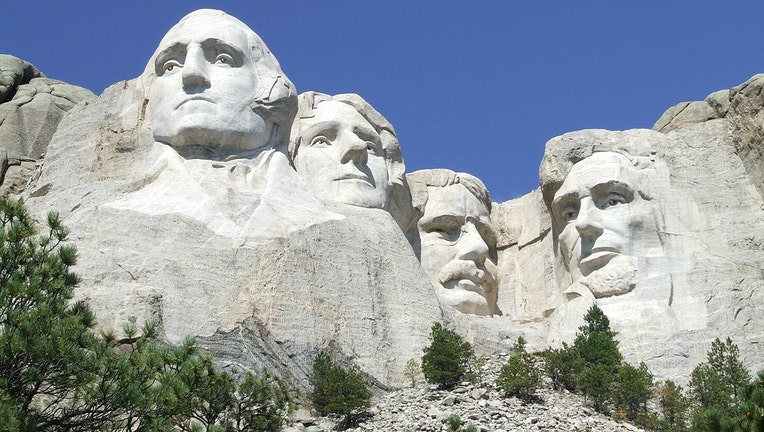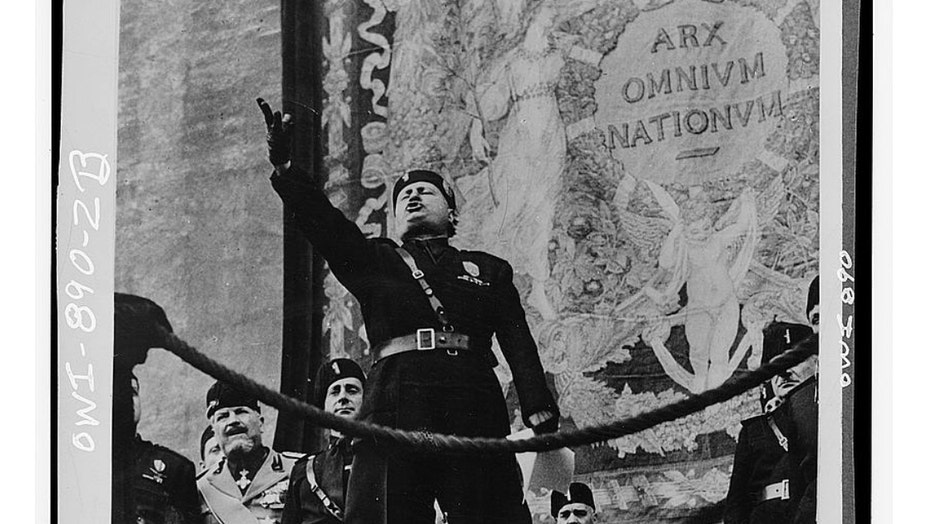1925: Here are things that happened 100 years ago

Mount Rushmore is pictured in a file image. (Credit: NPS)
As the calendar year turns to 2025, here’s a look back at a century ago – when Adolf Hitler published his infamous "Mein Kampf" manifesto, there was a debate over the teaching of evolution in schools, and many famous and influential figures were born.
Here are some of the significant events from 100 years ago, in 1925:
Jazz Age in full swing
In 1925, the Jazz Age was in full swing, PBS notes. The era, which saw jazz music and dance styles become popularized, was characterized by flamboyant culture and a rejection of old social conventions.
The Jazz Age began after World War I and the onset of women’s suffrage and Prohibition in the U.S., and ultimately faded away with the stock market crash of 1929, among other factors.
"The Great Gatsby," written by F. Scott Fitzgerald, was published on April 10, 1925 – helping to capture the rise of the Jazz Age through the book’s characters, themes, and music.
‘Phantom of the Opera’ released in theaters
"The Phantom of the Opera," a silent horror film adaptation of Gaston Leroux's 1910 novel of the same name, first premiered on Sept. 6, 1925 at the Astor Theatre in New York.
The film starred Lon Chaney as the deformed Phantom who haunts the Paris Opera House and tries to make the woman he loves a star.
It was both a critical and commercial success, and there have been many other adaptations since – including the Tony Award-winning musical composed by Andrew Lloyd Webber, and Joel Schumacher's "The Phantom of the Opera," a 2004 film starring Gerard Butler, Patrick Wilson and Emmy Rossum.
Mount Rushmore National Memorial dedicated in South Dakota
On Oct. 1, 1925, a dedication of Mount Rushmore as a national memorial with a flag ceremony was held. Carving officially began in 1927, and it wasn’t until 1941 that Mount Rushmore National Memorial was declared a completed project.
Mount Rushmore pays tribute to four U.S. presidents – George Washington, Thomas Jefferson, Theodore Roosevelt, and Abraham Lincoln – with their faces carved into a mountainside in the Black Hills of South Dakota.
The dangerous work, led by sculptor Gutzon Borglum, involved nearly 400 people. Ninety percent of the mountain was carved using dynamite, according to the National Parks Service.
Today, Mount Rushmore National Memorial welcomes over 2 million visitors each year from across the country and around the world.
Adolf Hitler’s manifesto published "Mein Kampf"
Importance of Holocaust Remembrance Day
Saturday marked 79 years since Holocaust survivors were liberated from Nazi death camps. Dr. Dan McMillan, author of 'How Could This Happen: Explaining The Holocaust' joined LiveNOW from FOX's Josh Breslow to discuss the significance of International Holocaust Remembrance Day.
On July 18, 1925, Adolf Hitler’s book, "Mein Kampf" – or "My Struggle" – was published. He wrote the manifesto in prison, where he was serving a sentence for a failed coup he attempted in 1923.
In the book, Hitler wrote about his ideology, his life, his "conversion" to antisemitism – or the hatred of Jews, according to a synopsis by The Anne Frank House, a house-turned-museum in Amsterdam where Anne Frank went into hiding during the war.
Hitler criticized the Treaty of Versailles and the reparations that Germany had to pay because of the Treaty in the book. He also wrote about the future of Germany and his political ideas and plans, seeking to expand German territory in Eastern Europe and to throw the Jews out of Germany, "since he believed they threatened the survival of the German people," the museum said.
The book was written in two volumes. The first volume, called Eine Abrechnung ("A Reckoning"), was published in July 1925. The second, Die Nationalsozialistische ("The National Socialist Movement"), was issued in December 1926, according to Yad Vashem, the World Holocaust Remembrance Center. After 1930, the two volumes were combined into one.
"Although not written very well, Mein Kampf was a wild success," Yad Vashem said.
By 1939, 5.2 million copies had been sold, and it had been translated into 11 languages. By 1945, about 10 million copies were in publication, the World Holocaust Remembrance Center said.
Scopes ‘Monkey Trial’ held over teaching evolution
The Scopes "monkey trial" in 1925 put the debate over teaching evolution in schools on the front pages of newspapers across the country. More broadly, the case highlighted traditional views and values colliding with more modern ones.
It centered on the prosecution of a criminal action brought by the state of Tennessee against 24-year-old high school teacher John T. Scopes, according to the Free Speech Center at Middle Tennessee State University. Scopes was accused of violating Tennessee’s Butler Act, which prohibited the teaching of evolution in public schools.
Scopes taught in the public high school in Dayton, Tenn., and agreed to be the focus of a test case attacking the new law. He was arrested for teaching evolution and tried with the American Civil Liberties Union backing his defense.
William Jennings Bryan, a three-time Democratic presidential candidate and a fundamentalist hero, volunteered to assist the prosecution, according to the History Channel. Legendary attorney Clarence Darrow soon after agreed to join the ACLU in the defense, and the stage was set for "one of the most famous trials in U.S. history," the outlet added.
Ultimately, Scopes was found guilty and fined $100. However, on appeal, the Supreme Court of Tennessee later overturned Scope’s conviction, pointing to a technicality in the issuance of the fine – while finding the Butler Act constitutional, the Free Speech Center said.
The constitutional issues were left unresolved until 1968, when the U.S. Supreme Court overturned a similar Arkansas law on the grounds that it violated the First Amendment, the History Channel noted.
Benito Mussolini solidified dictatorship in Italy

Benito Mussolini is pictured in an undated file image provided by the Office of War Information photograph collection (Library of Congress).
Just like Adolf Hitler, Italian Fascist leader Benito Mussolini did not become a dictator in a day.
In fact, Mussolini and his allies worked for several years to accrue power, slowly "eroding democratic constitutions until the moment came for them to be done away with entirely," according to the History Channel. In 1921, Mussolini won a seat in parliament as the leader of the growing National Fascist Party.
The moment that Mussolini "solidified" his dictatorship in Italy is generally agreed that it happened on Jan. 3, 1925, in a speech he gave to the Italian parliament, the History Channel said. During the speech, Mussolini asserted his right to supreme power and effectively became the dictator of Italy.
1st major march of the KKK in Washington D.C.
On Aug. 8, 1925, the Ku Klux Klan (KKK) brought nearly 40,000 members in full regalia to Washington, D.C., for a march down Pennsylvania Avenue in a show of force.
According to the book "The Ku Klux Klan in the City, 1915–1930" by Kenneth T. Jackson, the states with the most members were Indiana, Ohio, Texas, Pennsylvania, Illinois, Oklahoma, New York, Michigan, Georgia, New Jersey and Florida.
The first Klan was established in the wake of the Civil War. This iteration of the white supremacist hate group formed after the 1915 release of the film "The Birth of a Nation," which revived interest in the KKK and led to the birth of several new local groups that summer and fall, according to the FBI.
In the early 1920s, membership in the KKK quickly escalated to six figures under the leadership of "Colonel" William Simmons and advertising guru Edward Young Clarke, the agency said.
"By the middle of the decade, the group boasted several million members," the FBI said. "The crimes committed in the name of its bigoted beliefs were despicable—hangings, floggings, mutilations, tarring and featherings, kidnappings, brandings by acid, along with a new intimidation tactic, cross-burnings. The Klan had become a clear threat to public safety and order."
But just as quickly as the Klan rose in membership and influence, it collapsed, according to a history by the Bill of Rights Institute.
"There were many reasons. Some members were embarrassed by the organization’s bigotry, some by its silly regalia and ceremonies, or its money grubbing," it wrote. "Others were repulsed by its violence or its hypocrisy."
By the end of the decade, the KKK had faded into the background. A third revival emerged after World War II related to opposition to the growing civil rights movement.
Notable people born in 1925
- Paul Newman (Jan. 26, 1925)
- Malcolm X (May 19, 1925)
- Barbara Bush (June 8, 1925)
- B.B. King (Sept. 16, 1925)
- Margaret Thatcher (Oct. 13, 1925)
- Angela Lansbury (Oct. 16, 1925)
- Johnny Carson (Oct. 23, 1925)
- Doris Roberts (Nov. 4, 1925)
- Richard Burton (Nov. 10, 1925)
- Dick Van Dyke (Dec. 13, 1925)
The Source: This story was written citing various sources, including the History Channel, PBS, the National Parks Service, The Anne Frank House, Yad Vashem, the Free Speech Center at Middle Tennessee State University, and the FBI. It was reported from Cincinnati.

